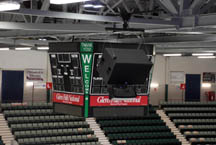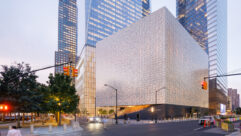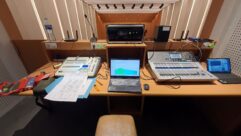
SVC Podcast – Show Notes – Show 175-2
In this edition of the SVC Podcast, Contributing Editor Bennett Liles talks with Seth Waltz of AVL Designs in Penfield, New York about their new sound system design for the Glens Falls Civic Center in upstate New York. Seth details the microphones, mixer and intelligibility testing of the new sound system.
For Part 1
Links of interest:
- Electro-Voice RE20 announcer microphone
- Midas M32R mixer
- Ashly ne24.24M matrix processor
- Ashly nXe 3.04 four-channel amplifiers
Download Podcast Here:
https://s3.amazonaws.com/nb-svc/public/public/Glens_Falls_AVL_Designs_Wa…
This is the SVC Podcast from Sound & Video Contractor Magazine with Seth Waltz of AVL Designs, Incorporated. Show notes and equipment links for the podcast are on the web site of Sound & Video Contractor Magazine at svconline.com.
The Glens Falls Civic Center in upstate New York had problems with acoustic dead spots and box-holder sightlines. AVL Incorporated from the nearby Rochester area provided a new sound system design with Danley speakers, a new mixer and new mics. Seth Waltz is here to give us the story, coming up on the SVC Podcast.
And here we are for Part 2 and Seth, thanks for being back with us from AVL Designs Incorporated in Penfield, New York. We were talking last week about the Glens Falls Civic Center. You got the new sound system installed and the first event was a wrestling match. You had Danley SH96 speakers and we talked about the rigging and speaker placement but we didn’t mention the folks out there doing all the sweating. Who did the actual rigging and installation?
Well, the contractors who got the job was Brown Sound out of Syracuse, New York was the primary contractor. They have since become a company called PCC AV. They merged with another company, still in Syracuse. And they hired BMI Supply out of Queensbury to do the rigging, and BMI is a stage rigging contractor that we’ve used on a lot of our theater projects. And we were actually glad they chose these guys because this was a complex rigging job to get these speakers to hang the way they needed to because it was oblique hanging. It was really unusual rigging techniques and they did a great job. [Timestamp: 1:48]
And we mentioned before that you had a little bit of an advantage in that the old system didn’t have to be taken out before you got started on the installation of the new one.
Right. And the good and bad of that is that the true install time, if they had started on day one and ended the job when they were finished, it would have been about six weeks total install. But because the other system was still operational they kept scheduling events so the contractors had to start and stop quite a bit. So it ended up taking quite a few months even though the linear time was about a six-week install. [Timestamp: 2:21]
Right. The other side of it. You obviously couldn’t be in there working while there’s any kind of a show going on and that’s a lot of different kinds of events.
Yep.
Everything from graduations to wrestling matches to music concerts so the new sound system had to work for all of those things.
Yep. It’s a very multi-use space.
And when did you get to really ring out and test that system? I would think before anybody else was in there.
Yeah. We did one day of commissioning where we came in with the contractor. We basically equalized the system, which in this case is very easy because all 14 clusters are EQ’d exactly the same. And we did intelligibility testing to remap the room and compare it to the original. So areas where we had STI’s of .4 were reading in the .8 range. The entire room was in excess of .8 even with the high reverb time. We did all of that on a day with nobody else in the place, but our first real day of working with the console and everything else they had a rodeo in the room operating while we were trying to get all of that done. [Timestamp: 3:21]
Yeah, you may have gotten more cooperation out the animals that the people on that one.
Exactly.
And you incorporated some of the existing gear and then had to move that so it was an ongoing process. What did they do for mics in the new setup? Did they get new mics?
Yeah. Their existing wireless are all Shure with SM58 heads which we did keep because the guys who use those, they just are comfortable with them. They already owned them. The primary announcer for hockey is a broadcast announcer. We met the guy. He’s got a great voice and he’s used to using real microphones so we got him an RE20 and he was thrilled. It lets him work the way he’s used to working and we don’t have any proximity effect problems. So that mic sounds dramatically better than any of the hand-helds they have. So we blended them so they all sound enough alike that you can make it all work. [Timestamp: 4:11]
Well, if he’s in radio he’s probably very familiar with the RE20. Just about everybody on the radio airwaves uses that one.
Yeah. That’s actually what’s at his station so he was thrilled to see that show up.
And so what did you give them for a house mixer?
We ended up going with the Midas M32, the compact version. I think they call it an M32R. And originally they used to have a Yamaha 01V, that was their old console and they felt it was kind of complicated. That’s obviously a very early generation digital board. But this one was primarily because we could color code and label everything on the console and the scribble strips in a way that lets the various users really use this thing without getting lost. Because we have everything from maintenance people to real sound people depending on the event running the system. [Timestamp: 4:58]
Oh, well that makes it a lot more interesting. It would be a lot easier if they just had one veteran sound person doing everything. But to make that work for everybody is certainly going to be a bigger job.
Yeah, we programmed a lot of presets for a lot of different uses of the room. There’s a local sound engineer in that area that we know quite well that we had involved so that if they have to retune a preset we don’t have to go all the way up there to help them out with it. But they’ve been successful. Since the system was installed and finalized it’s probably been, oh, it’s got to be nine months now. We haven’t had a single call, which is really good with a digital console to not have any phone calls for how do I do this? [Timestamp: 5:37]
It’s definitely a no-news-is-good-news thing.
Yeah. And they have an iPad interface so they’re able to take the iPad and go down to the seating area, remote the console. They learned how to do that and they love the fact that they can actually do level verification and minor EQ tweaks during an event down in the seating area. Because the console is elevated high enough that it’s not getting the main system. We’ve got some delayed RCF’s that are up there for booth monitors and they sound pretty close to the main system, but it’s still better to get down on the seats. [Timestamp: 6:09]
You can take a great system with all the best gear in it, put it in the wrong place and have lots of trouble with it. But it sounds like you got it all worked it out.
Yes. We had to work with where the press was. They wanted this all to be up where the press operators were, so. But the remote – all the new consoles that have good iPad apps are phenomenal. Just to be able to walk around and listen, it’s really a nice feature. [Timestamp: 6:30]
Yeah, real nice when you’re first getting the system up and testing everything. It’s got to be incredibly handy and save a lot of shoe leather.
It does. And we also were able to give them the Ashly remote which lets them turn off individual clusters. So if they have a hockey game that literally nobody is sitting in whatever seating area it might be they can shut any cluster down that they want to off of the iPad so that they’re not generating more reverberation in the room. Because obviously anything you can turn off in a room that’s that live is a good thing. [Timestamp: 6:59]
And to be able to do that to suit any type of event. So it looks like you got through this one OK. Have you got any new projects in the works that you can tell us about?
We’ve got a couple of interesting ones. One is not really an audio-related one, but we’re doing a relatively large-scale television studio right now that is cloud-based broadcasting to all the major networks. That’s at a university up in Albany. So that’s an interesting project because we’re doing all the lighting and video and the whole nine yards for that. And in audio we’ve got an interesting theater we’re doing right now. It’s actually a high school, but it’s a 1,000-seat space where we’re doing electronic acoustics for the room which we do in a lot of venues. We’ve got about 25 electronic acoustic systems out in the field right now which are all based on Yamaha AFC technology. But in this one we’re also applying basically the ability to do a Dolby Atmos-style surround using all of the same devices. So the main theater is going to have, I think, somewhere in the range of about 100 loudspeakers all individually Dante-connected and then we’re going to have three large rehearsal spaces that also have electronic acoustics so that they can rehearse in an environment that sounds just like their stage. And all of these are being tied together with Dante so they can do recording and special effects for shows and just about anything they want to do. And one of the things we’re in the middle of making final decisions on, it’s kind of a similar Danley thing. We’re looking at the Danley Jericho series loudspeakers because we – in modeling we’ve found, we can get a better sound out of those budget-wise and fidelity-wise than any of the line arrays we’ve been trying. It’s not finalized with the owner yet because they originally said they’d like a line array solution, but in terms of what we’re coming up with we feel the Jericho would be a better solution for them. It’s better direct field coverage, better overall coverage and sound pressure capability. [Timestamp: 8:52]
Sounds like a lot of advance planning going on for those.
Yep. It’s a complicated space. They’re a very active theater department school and they will actually make use of all the stuff, which is always a good feeling. I hate to give people things that they never end up using. [Timestamp: 9:06]
Yeah, if they’re too complicated for the local operators, they’re probably going into a closet.
Exactly.
Thanks for telling us about this one Seth. It’s Seth Waltz from AVL Designs Incorporated in Penfield, New York and the new Glens Falls Civic Center sound system. Good hearing about it.
All right. Thanks for calling.
Thanks for joining us on the SVC Podcast with Seth Waltz of AVL Designs Incorporated. Show notes and equipment links are on the website of Sound & Video Contractor Magazine at svconline.com. Be right back here with us again next week for the SVC Podcast.










